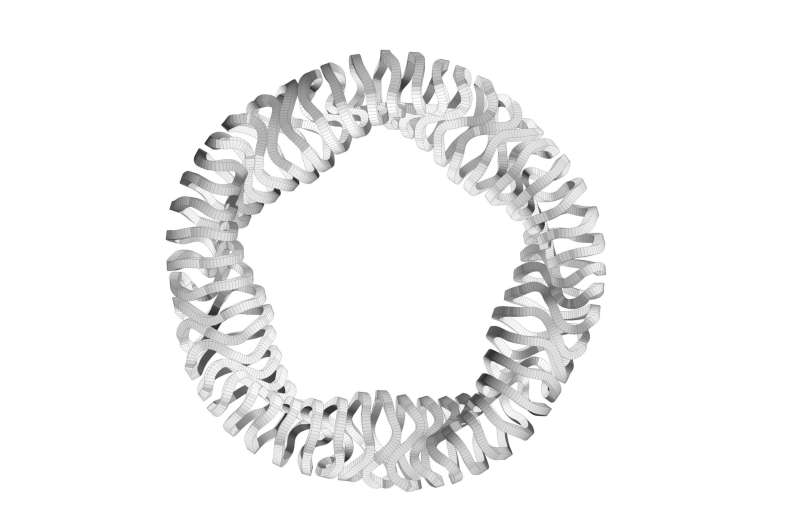The Wendelstein 7-X concept proves its efficiency

One of the most important optimisation goals underlying the Wendelstein 7-X fusion device at Max Planck Institute for Plasma Physics (IPP) in Greifswald has now been confirmed. An analysis by IPP scientists in the journal Nature shows: In the optimized magnetic field cage, the energy losses of the plasma are reduced in the desired way. Wendelstein 7-X is intended to prove that the disadvantages of earlier stellarators can be overcome and that stellarator-type devices are suitable for power plants.
The optimized Wendelstein 7-X stellarator, which went into operation five years ago, is intended to demonstrate that stellarator-type fusion plants are suitable for power plants. The magnetic field, which encloses the hot plasma and keeps it away from the vessel walls, was planned with great theoretical and computational effort in such a way that the disadvantages of earlier stellarators are avoided. One of the most important goals was to reduce the energy losses of the plasma, which are caused by the ripple of the magnetic field. This is responsible for plasma particles drifting outwards and being lost despite being bound to the magnetic field lines.
Unlike in the competing tokamak-type devices, for which this so-called “neo-classical” energy and particle loss is not a major problem, it is a serious weakness in conventional stellarators. It causes the losses to increase so much with rising plasma temperature that a power plant designed on this basis would be very large and thus very expensive.
In tokamaks, on the other hand—thanks to their symmetrical shape—the losses due to the magnetic field ripple are only small. Here, the energy losses are mainly determined by small vortex movements in the plasma, by turbulence—which is also added as a loss channel in stellarators. Therefore, in order to catch up with the good confinement properties of the tokamaks, lowering the neoclassical losses is an important task for stellarator optimisation. Accordingly, the magnetic field of Wendelstein 7-X was designed to minimize those losses.
In a detailed analysis of the experimental results of Wendelstein 7-X, scientists led by Dr. Craig Beidler from IPP’s Stellarator Theory Division have now investigated whether this optimisation leads to the desired effect. With the heating devices available so far, Wendelstein 7-X has already been able to generate high-temperature plasmas and set the stellarator world record for the “fusion product” at high temperature. This product of temperature, plasma density and energy confinement time indicates how close you get to the values for a burning plasma.
Such a record plasma has now been analyzed in detail. At high plasma temperatures and low turbulent losses, the neoclassical losses in the energy balance could be well detected here: they accounted for 30 percent of the heating power, a considerable part of the energy balance.
The effect of neoclassical optimisation of Wendelstein 7-X is now shown by a thought experiment: It was assumed that the same plasma values and profiles that led to the record result in Wendelstein 7-X were also achieved in plants with a less optimized magnetic field. Then the neoclassical losses to be expected there were calculated—with a clear result: they would be greater than the input heating power, which is a physical impossibility. “This shows,” says Professor Per Helander, head of the Stellarator Theory Division, “that the plasma profiles observed in Wendelstein 7-X are only conceivable in magnetic fields with low neoclassical losses. Conversely, this proves that optimizing the Wendelstein magnetic field successfully lowered the neoclassical losses”.
However, the plasma discharges have so far only been short. To test the performance of the Wendelstein concept in continuous operation, a water-cooled wall cladding is currently being installed. Equipped in this way, the researchers will gradually work their way up to 30-minute long plasmas. Then it will be possible to check whether Wendelstein 7-X can also fulfill its optimisation goals in continuous operation—the main advantage of the stellarators.
Background
The aim of fusion research is to develop a climate- and environmentally-friendly power plant. Similar to the sun, it is to generate energy from the fusion of atomic nuclei. Because the fusion fire only ignites at temperatures above 100 million degrees, the fuel—a low-density hydrogen plasma—must not come into contact with cold vessel walls. Held by magnetic fields, it floats almost contact-free inside a vacuum chamber.
The magnetic cage of Wendelstein 7-X is created by a ring of 50 superconducting magnetic coils. Their special shapes are the result of sophisticated optimisation calculations. With their help, the quality of plasma confinement in a stellarator is to reach the level of competing tokamak-type facilities.
Successful second round of experiments with Wendelstein 7-X
C. D. Beidler et al, Demonstration of reduced neoclassical energy transport in Wendelstein 7-X, Nature (2021). DOI: 10.1038/s41586-021-03687-w
Citation:
The Wendelstein 7-X concept proves its efficiency (2021, August 12)
retrieved 12 August 2021
from https://phys.org/news/2021-08-wendelstein-x-concept-efficiency.html
This document is subject to copyright. Apart from any fair dealing for the purpose of private study or research, no
part may be reproduced without the written permission. The content is provided for information purposes only.
For all the latest Science News Click Here
For the latest news and updates, follow us on Google News.

